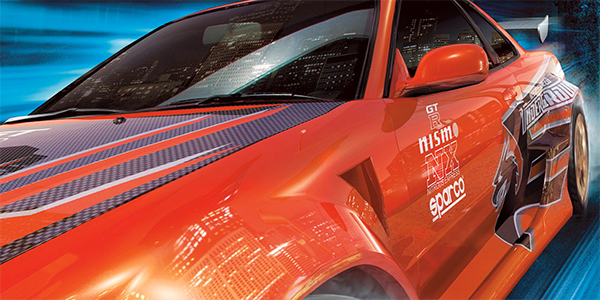Immediately upon reaching the title screen for 2003’s Need for Speed: Underground, there is an intense feeling of excitement and guilty pleasure, as “Get Low” by Lil Jon & The East Side Boyz begins to blast from your TV speakers and at the same time, an orange Nissan Skyline covered in decals drives in from the corner of the screen. It’s an efficient way to communicate the sort of tone developer EA Blackbox is going for with this game; one heavily inspired by the street racing lifestyle that captivated so many of us after the release of the film The Fast and the Furious in the early 2000’s.
Underground is the most successful entry and sub-brand of the Need for Speed franchise. For the series, at least commercially, it appears that it peaked here. Of course there were other street racing games out at the time, Midnight Club and Juiced, but Underground was by far the most popular. It’s also the one I’m most familiar with. That first installment in the Underground sub-brand caught lightning in a bottle. People like myself and my friends back in 2000 were fascinated with that world of illegal street racing. A world fueled by Nitrous Oxide Systems (NOS), neon light kits, intricate tire rims (DUBS), and the criminal intrigue/melodrama that appeared in the first set of Fast and Furious films. Underground gave those people an outlet to implant themselves in those spaces by giving the Need for Speed franchise a new coat of paint, but going back to it today made me realize that even though the game provides some of those elements and I have fond memories of it, my imagination was filling in a lot of the missing blanks to compensate for where it falls short.
Playlist comparing a scene from The Fast and Furious with the intro cinematic for Need for Speed: Underground
The closest Underground really gets to being the thing you want it to be is that title screen; it’s equal parts genuinely cool and ironically cool. “Get Low” is also the highlight of an “okay” soundtrack headlined by T.I., Nate Dogg, and Rob Zombie. The rest feels like it focuses in on the ‘greatest hits’ of our collective street racing knowledge and that of Fast and Furious.
There are the blocked off, late night races lit by the glow of a downtown metropolis and the large groups of racing enthusiasts huddled around meticulously customized vehicles. But those same streets and tracks begin to become indistinguishable. They look the part of a lively city at first, but they lack character and identity. I have memories of these intense races being in varied environments, but now it all blends together. Although, it’s charming to race in locations that are stuck with in-game billboards advertising products of the 2000s.
Missing from the fantasy, at least for the early hours of the game, is a slick ride, as it takes a while to get a car you feel comfortable going all in on customizing. Racing around, at least for a good while, in a 2003 Dodge Neon can feel disheartening and frustrating as you slam that accelerate button and gain little momentum. This was always an issue, but I didn’t mind grinding for experience, participating in non-intensive racing, and scrabbling for in-game currency when I was kid with no responsibilities.
Of course, it wouldn’t be a product inspired by Fast and Furious without a silly and theatrical narrative filled with bravado, betrayals, and light sexual tension. Underground sort of has this, but it’s a cliffnotes version of it that doesn’t walk the line between seriousness and parody.
It’s the story of a new kid in town who wants a piece of the action. There’s a female veteran that takes him under her wing to teach him the streets. Obviously there’s the number one street racer in town who parades his masculinity and attractive girlfriend, and of course the player character wants to become better acquainted with her. The beats are familiar, and you can probably predict the trajectory of it. In hindsight, it strangely resembles the narrative of The Fast and Furious: Tokyo Drift. Apart from the story beats one would absolutely need to tell this story, the narrative is light with short, silly cutscenes and it all comes across as the cartoonish fantasy of a young dude, which I suppose is another thing the game shares with Fast and Furious.
While a lot of folks, myself included, champion Fast and Furious, it’s hard to ignore its ‘masculine’ overtones that were especially prevalent in the early entries of the series. They are very present in Underground. It’s the tendency to catch women in short skirts bending over as they pop open the hood of a car or the specific angles on flag girls before races start. In the case of Underground, it can only go so far because the game is rated ‘E’, but the camera still likes to linger on midriffs and it often presents women like shiny things to win in a manner that’s so blatant that it’s actually funny. That’s not to say that there is anything wrong with combining attractive women and stylish cars or that they can only, exclusively be appreciated by men, but it’s the specific and obtrusive way that these two pieces of media pander and go about this that makes it feel cheap and kind of gross. When I was younger I gladly indulged in all of it, but now it makes Underground that much harder to buy into and fully enjoy. For comparison, a series that I’ve found approach this with a lot more style and refinement is the Ridge Racer series of games and their in-game female model, Reiko Nagase.
It’s always disappointing to find out that a seminal piece of your upbringing does not stand the test of time. Although, I never did get to play the follow-up to Underground and I have little memory of playing games like it that released around the same time. Perhaps those other games can bring me back to a time and a place. While my feelings on Underground are a bit more complicated now, I will always have some amount of fondness for it and what it meant to me at the time. Regardless of all of that, Underground still has a pretty great title screen.








